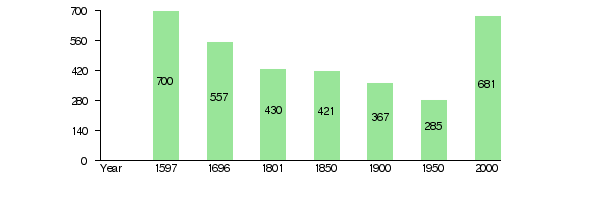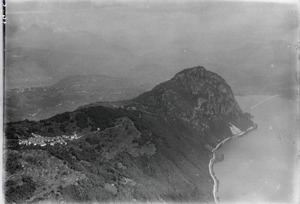Carona, Ticino facts for kids
Quick facts for kids
Carona
|
||
|---|---|---|
 |
||
|
||
| Country | Switzerland | |
| Canton | Ticino | |
| District | Lugano | |
| Area | ||
| • Total | 4.75 km2 (1.83 sq mi) | |
| Elevation | 597 m (1,959 ft) | |
| Population
(Dec 2011)
|
||
| • Total | 827 | |
| • Density | 174.11/km2 (450.9/sq mi) | |
| Postal code |
6914
|
|
| Surrounded by | Lugano, Melide, Morcote, Vico Morcote | |
Carona was once a small town, or municipality, in the Ticino area of Switzerland. It was part of the Lugano district. On April 14, 2013, Carona joined with several other towns like Bogno, Cadro, and Sonvico to become part of the larger city of Lugano.
Contents
History of Carona
Carona was first mentioned in old writings in the year 926. It was called Calauna back then. A smaller village nearby, called Ciona, was first mentioned in 1213.
During the Middle Ages, Carona and Ciona were special areas controlled by the Bishop of Como. The Church of Santa Maria was built in the village of Torello during this time. Later, in 1349, a group of Augustinian monks helped support this church.
Carona was loyal to powerful families like the Visconti. Because of this loyalty, the village received its own coat of arms. It also had a special status, meaning it didn't have to follow some laws or pay certain taxes. The old rules for the village were updated in 1470.
The old stone church of San Giorgio in Carona was first mentioned in 1425. Two years later, it became a main church for the area. The Church of S. Marta was built in the 14th century. Later, in 1624, the beautiful Madonna d'Ongero church was built in the forest. The Church of S. Maria delle Grazie was built in Ciona. These churches and the homes from the 1600s and 1700s show how wealthy the village became. Many artists from Carona traveled and worked all over Europe during these centuries. Famous artist families like the Aprile, Casella, Scala, and Solari families came from Carona.
Carona was mainly a farming village until the early 1800s. Then, nearby Lugano became a popular place for tourists. In 1943, a hill called S. Grato was cleared for farming, but later the buildings there became a vacation spot. After many years of fewer people living there, Carona's population grew a lot in the 1970s and 80s. Many new homes were built outside the old village center. By 2000, about 21% of the people in Carona spoke German. Today, Carona has a large swimming pool and sports center for everyone in the area.
Geography and Nature
Before it joined Lugano, Carona covered about 4.8 square kilometers (about 1.85 square miles). A small part of this land, about 9.7%, was used for farming. Most of the area, about 84.6%, was covered by forests. The rest of the land had buildings, roads, or was unproductive.
Carona is located in the Lugano district. It sits between the S. Salvatore and Arbostora mountains, close to Lake Lugano. The area includes the main village of Carona and the smaller villages, or hamlets, of Ciona and Torello.
Carona is also home to Parco San Grato. This park offers amazing views of Lake Lugano. It has a beautiful collection of azaleas, rhododendrons, and conifer trees.
Carona's Coat of Arms
The official design of Carona's coat of arms shows a silver church with red windows and doors. This church sits on a silver cliff that rises out of a blue lake at the bottom.
People and Population
In 2011, Carona had a population of 827 people. About 19.5% of the people living there in 2008 were from other countries. Over ten years (from 1997 to 2007), the population grew by about 10.1%.
Most people in Carona speak Italian (about 69.8%). The second most common language is German (21.0%), and English is third (4.0%).
In 2008, there were slightly more women (53.5%) than men (46.5%) living in Carona. The population included both Swiss citizens and people from other countries.
The population of Carona has changed over time. Here's how it looked in different years:

Important Historical Buildings
Several buildings in Carona are considered very important historical sites in Switzerland. These include:
- The Church of Della Madonna D’Ongero.
- The main church of SS. Giorgio e Andrea, which has a community center.
- The Complex of S. Maria Assunta di Torello.
The entire village of Carona, along with Ciona and Torello, is listed as an important Swiss heritage site.
Famous People from Carona
- Giuseppe Antonio Petrini (1677- around 1755–9): A painter from the late Baroque period. He was born in Carona and mainly worked in Lugano.
- Pietro Antonio Solari (around 1445 – May 1493): An architect and sculptor. He worked for Ivan III in Russia. He was born in Carona and passed away in Moscow.
Economy and Jobs
In 2007, Carona had a low unemployment rate of 3.07%. In 2005, a few people worked in farming (the primary sector). A small number of people worked in manufacturing (the secondary sector). Most people, 41 individuals, worked in services like shops or tourism (the tertiary sector).
Many people who lived in Carona traveled to other towns for work. In 2000, about 61.1% of working people used a private car to get to their jobs. About 11.3% used public transportation.
As of 2009, Carona had one hotel.
Religion
According to the 2000 census, about 59.0% of the people in Carona were Roman Catholic. About 12.2% belonged to the Swiss Reformed Church. Some people belonged to other churches, and a small number did not state their religion.
Education
Switzerland has a very good education system. In Carona, about 81% of adults (aged 25-64) have completed either high school or higher education like university.
In 2009, there were 98 students in Carona. The education system in Ticino offers up to three years of optional kindergarten. In Carona, 4 children were in kindergarten. Primary school lasts for five years. In Carona, 39 students attended regular primary schools.
After primary school, students go to lower secondary school. They can either attend a two-year middle school or a four-year program to prepare for higher education. There were 23 students in the two-year middle school and 15 in the four-year program.
Upper secondary school prepares students for a trade or for university. Students can learn a trade while working or attend school full-time. In Carona, 6 students were full-time vocational students, and 9 were part-time. There was also 1 student in a professional program, which prepares students for jobs in fields like engineering or nursing.
In 2000, 116 students from Carona went to schools outside the municipality.
See also
 In Spanish: Carona (Tesino) para niños
In Spanish: Carona (Tesino) para niños






